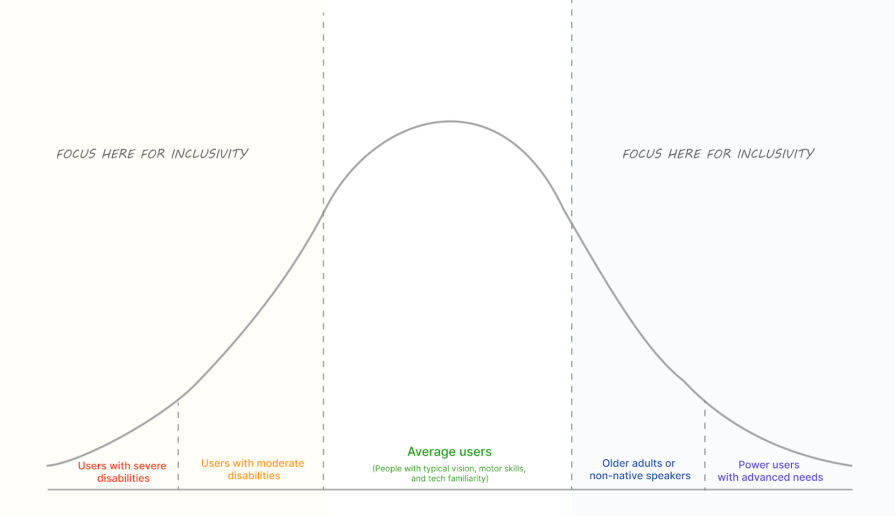If your research isn’t inclusive, neither is your design
Inclusive design doesn’t start on a Figma file or on a sketchpad. It starts way before that — with understanding your users so you can design solutions that genuinely work for them. And that kind of insight doesn’t just happen; it takes intentional, inclusive research.
Don’t worry — it’s never too late to start making inclusive design choices. You can introduce them at any point in your product development process. But here’s the thing — inclusivity is most effective (and least expensive) when it’s woven in from the very beginning.
If you’re trying to figure out how to put inclusion front and center in your UX research, you’re in the right place. We’ll walk through what inclusive research means, why it matters, how to actually do it — and we’ll bust a few myths along the way.
What is inclusive UX research?
Let’s get one thing straight. Inclusive research isn’t a specialized practice or a separate discipline you need to master. It’s just a more thoughtful, more expansive version of what you’re already doing.
It means zooming out of the idea of the “average user” and intentionally bringing in perspectives from people who don’t always show up in mainstream research — folks with disabilities, neurodivergent people, older adults, people from different cultural or economic backgrounds, and others who don’t fit the one-size-fits-all mold.

To put things into perspective, let’s zoom in on the Bell curve in the figure above:
- The middle section represents what’s commonly considered the average user. These users have typical vision, motor skills, and tech familiarity, and are the most likely to be recruited for research
- The far left tail (users with severe disabilities) and the left slope (users with moderate disabilities) represent a smaller portion of the population. These users face unique challenges and interact with the world differently. Understanding how they navigate obstacles offers valuable insights for creating better products for everyone
- The right tail (power users with advanced needs) and right slope (users with diverse interaction preferences, like older adults or non-native speakers) also represent a small portion of the population. These users push the limits of technology or prefer different ways of interacting
Including the perspectives of these users helps ensure your product is adaptable and accessible to a broader audience.
Getting started: Start small, start now
It’s easy to assume that inclusive research is an expensive, complex effort reserved for large, successful companies. But that couldn’t be further from the truth.
You don’t need a huge budget or decades of experience to make your research more inclusive. All you need is mindfulness and the intention to do better. Here’s how:
- Include a small percentage of participants from marginalized groups — people with disabilities, older adults, low-income users, non-native speakers, etc.
- Aim to have at least 10–20% of your participants from these groups.
- Make your recruitment and research materials more accessible — use plain language, screen-reader-friendly forms, zero jargon, and offer flexible participation options like remote interviews.
- Ensure that your findings are reflected in the design outcome.
Even if you’re only talking to 10 users, bringing in just one or two from underrepresented groups can make a big impact. The insights you gain can uncover hidden pain points, improve design decisions, and help you build a better product for everyone.
Practical steps for inclusive UX research
Define your research goals with inclusivity in mind
When defining your research goals, make accessibility and inclusion a priority. For example, if you’re studying navigation on an e-commerce site, you can add questions like:
- How do users with visual impairments locate and access their shopping carts?
- How do non-native speakers interpret checkout instructions?
- How do users with impaired mobility navigate product filters?
- How does the checkout flow perform for a user with an unstable network connection?
Doing this can help spot gaps that standard usability testing often misses.
Take Microsoft’s design process for the Xbox Adaptive Controller as an example. They were intentional about including users with limited mobility in their research process. And this research led Microsoft to design a more accessible controller with large programmable buttons, custom input jacks, and a stable base for use on beds or wheelchairs.
Recruit a diverse range of participants
To gather meaningful and well-rounded insights, ensure your participants represent diverse backgrounds and experiences.
Finding diverse participants is easier than you might think:
- Look for online communities related to the specific groups you’re targeting. For example, to find neurodivergent users, search for autism, ADHD, or neurodiversity groups such as Autism Researchers Link on LinkedIn
- Partner with accessibility-focused organizations such as AbilityNet and Knowbility, which often have networks of people with disabilities open to participating in research
- Use online platforms like AccessWorks to recruit test participants with various accessibility needs
A clear example of what can go wrong without diverse input is Apple’s Health app in 2014. Despite tracking everything from steps to blood alcohol levels, the app left out a menstrual cycle tracker, an important feature for millions of menstruating women.
This costly oversight led to public criticism and forced the company to add the feature in a later update. The lesson here? Aim for diverse perspectives during the research phase to avoid costly redesigns (and possible backlash).
Build safety and trust
Participants from underrepresented groups are often overlooked, making it all the more important to create a space where they feel safe, heard, and respected.
Here’s how you can achieve that:
- Diversify your research team — People tend to feel more comfortable opening up to researchers with similar experiences or backgrounds. If you can’t build a diverse team, consider partnering with collaborators or contractors from underrepresented groups for specific projects
- Be transparent — Be upfront about the purpose of your research, how the data will be used, who has access to it, and what they can expect. Let them know they’re free to skip questions or withdraw at any time if they feel uncomfortable
- Use respectful, inclusive language — Avoid assumptions or default labels. Ask participants how they wish to be identified and referred to. For example, one person might prefer “autistic person,” while another might be more comfortable with “neurodivergent person.” Respecting these preferences helps build trust and shows you value each person’s identity
- Compensate fairly — Offer appropriate incentives to demonstrate your appreciation for your participants’ time and input
- Follow-up — If possible, share how participants’ feedback influenced the final product. This demonstrates that their input was valued and reinforces the fact that their voices had a genuine impact
Take Google’s Gboard voice recognition, for instance. In its early years, many voice recognition tools struggled to understand African American English. Some Black users even felt pressured to switch their accents just to be recognized by the technology.
Instead of sending in outsiders who didn’t get the culture, Google partnered with Howard University, which already had credibility in the Black community. They let community members lead the research, and treated participants as partners in improving the technology, not just data sources. The result? A voice recognition system that’s more accurate and makes users feel seen (and heard).
Integrate insights into design decisions
Getting inclusive insights is only half the story; what you do with them matters more. Use your findings to inform real product decisions, whether it’s adjusting a design, rethinking navigation, or adding accessibility features. Inclusive research should lead to inclusive design.
For example:
- If usability testing reveals that users with limited mobility struggle to interact with certain buttons, you may need to increase the touch target sizes and the spacing between elements
- If non-native speakers struggle to navigate a page due to unclear language or confusing instructions, consider simplifying the copy and adding visual cues
By turning your research insights into tangible design improvements, no matter how small, you can significantly enhance usability for all users.
Reflect and improve
Inclusion is a continuous learning journey. You’ll most likely never arrive at the “perfect” design that works as it should for everyone. And that’s okay. What matters, however, is that you consistently apply what you learn from each round of research to make meaningful improvements. These small changes can compound over time, leading to a product that’s more usable, accessible, and welcoming to a wider audience.
After each research cycle, reflect on what worked and what didn’t. Evaluate everything from your recruitment and research methods to communication and analysis. Ask questions like:
- Did our participant pool reflect the diversity we hoped for? If not, which groups were missing or underrepresented, and what steps can we take to include them next time?
- Were there any barriers that prevented any participants from fully engaging?
- Did the research insights lead to actionable design changes?
- Were there any unexpected insights that challenged our initial assumptions?
- Did we create a safe and welcoming space where all participants felt heard and respected?
- How can the research process be improved for next time?
Reflecting on each research cycle helps you build deeper empathy for your users, sharpen your research skills, and create more inclusive products.
Busting myths about inclusive UX research
| Inclusive research myth | Inclusive research fact |
| It only benefits a small group of users. | It leads to better products for everyone. When you design for the edges, you improve the experience at the center too. |
| It slows down the design process. | While it may add some extra steps, inclusive research can actually save time and effort in the long run. By building inclusive design into the process from the start, you avoid costly redesigns later. |
| You need perfect representation from every group. | It’s not always feasible to include every perspective in a single cycle. If you can’t include a user group in one round, prioritize their inclusion in the next. What matters is being consistent about broadening inclusion over time. |
| You need specialized skills or tools. | All you need is the right mindset. Stay curious, open, and willing to learn from diverse users. |
What to do next
- Pick a project you’re working on and ask yourself: who might this exclude? These questions can help you uncover exclusions:
- Who is the product generally intended for?
- What assumptions are we making about their abilities, context, or language skills?
- Once you’ve identified an excluded group, set a goal to recruit at least one participant from that group in your next research round.
- Audit your recruitment and research materials for accessibility:
- Do all non-decorative images include descriptive alt text?
- Are there multiple content formats (text, images, or videos) so participants can access information in a way that works best for them?
- Is the content written in plain, easy-to-understand language?
- Are there flexible participation options such as in-person sessions, remote interviews (with or without video), or unmoderated remote studies?
- Are your forms and platforms screen-reader friendly and keyboard navigable?
- Integrate all the practical steps we’ve shared in this guide.
The best part is that even the smallest changes informed by these insights can have a powerful, positive impact on the experience of all your users.
The post If your research isn’t inclusive, neither is your design appeared first on LogRocket Blog.
This post first appeared on Read More


